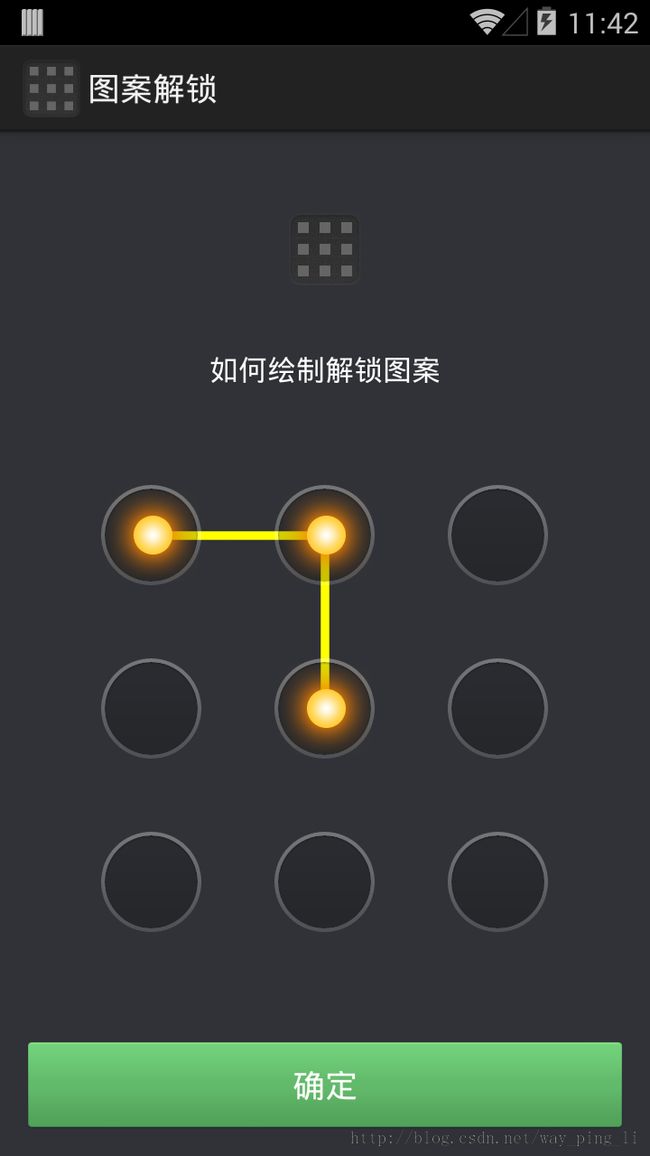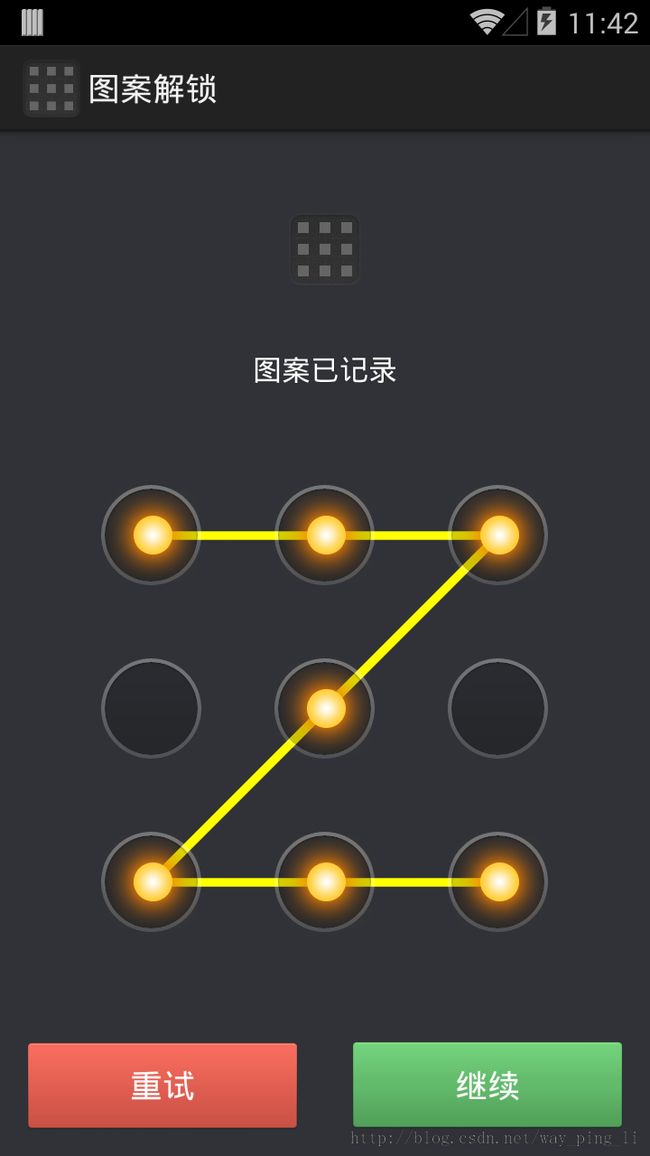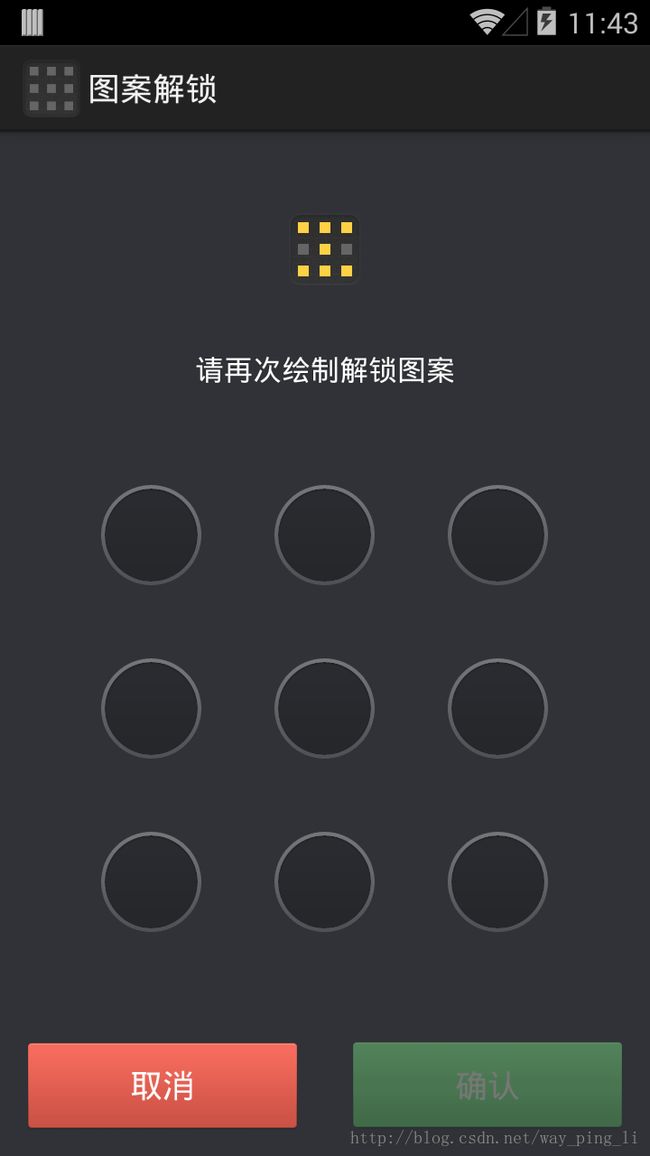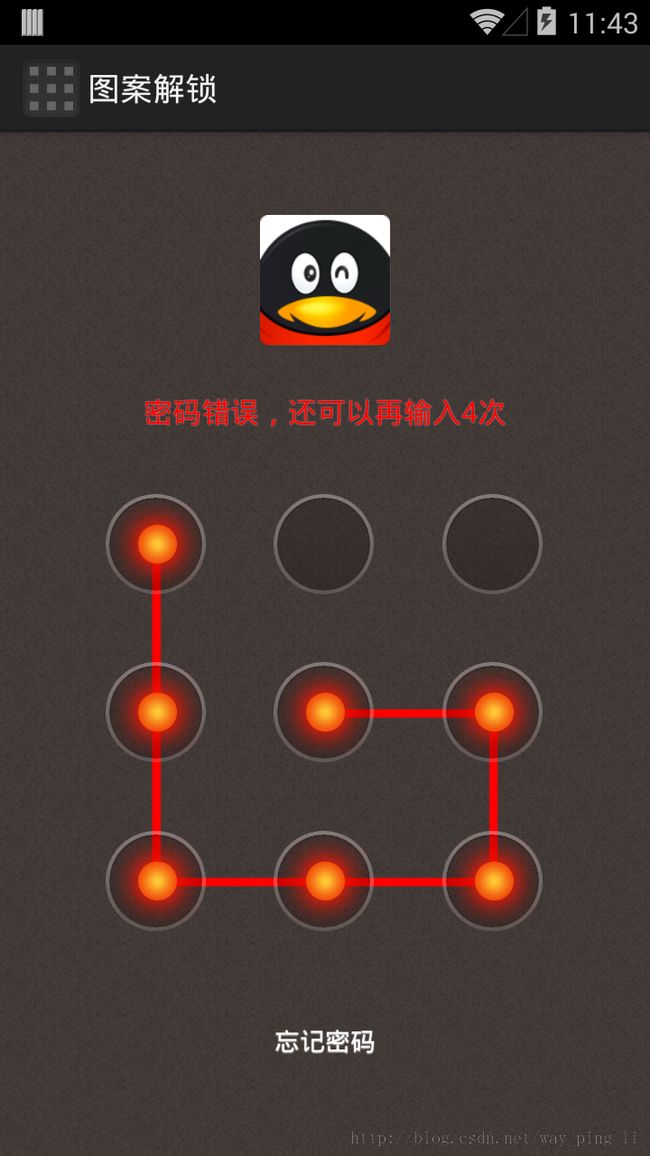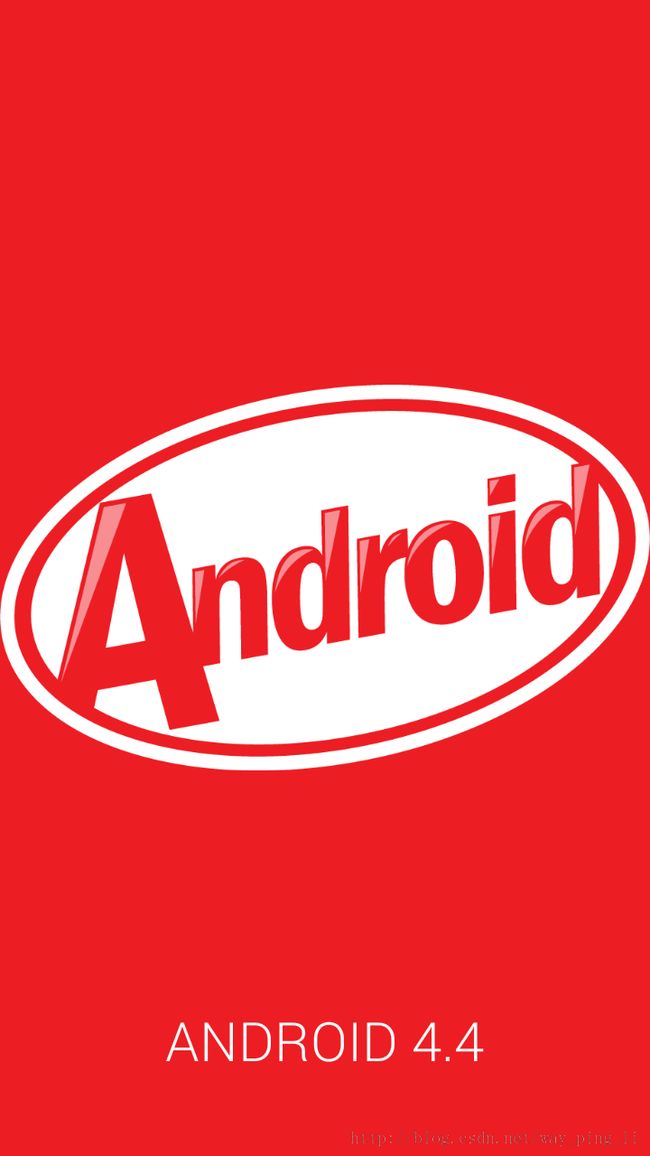Android之高仿手机QQ图案解锁
本文源码(utf-8编码):http://download.csdn.net/detail/weidi1989/6628211
ps:请不要再问我,为什么导入之后会乱码了。
其实,代码基本上都是从原生系统中提取的:LockPatternView、加密工具类,以及解锁逻辑等,我只是稍作修改,大家都知道,原生系统界面比较丑陋,因此,我特意把QQ的apk解压了,从中拿了几张图案解锁的图片,一个简单的例子就这样诞生了。
好了,废话不多说,我们来看看效果(最后两张是最新4.4系统,炫一下,呵呵):
1.最关健的就是那个自定义九宫格View,代码来自framework下:LockPatternView,原生系统用的图片资源比较多,好像有7、8张吧,而且绘制的比较复杂,我找寻半天,眼睛都找瞎了,发现解压的QQ里面就3张图片,一个圈圈,两个点,没办法,只能修改代码了,在修改的过程中,才发现,其实可以把原生的LockPatternView给简化,绘制更少的图片,达到更好的效果。总共优化有:①去掉了连线的箭头,②原生的连线只有白色一种,改成根据不同状态显示黄色和红色两张色,③.原生view是先画点再画线,使得线覆盖在点的上面,影响美观,改成先画连线再画点。
关健部分代码onDraw函数:
- @Override
- protected void onDraw(Canvas canvas) {
- final ArrayList<Cell> pattern = mPattern;
- final int count = pattern.size();
- final boolean[][] drawLookup = mPatternDrawLookup;
- if (mPatternDisplayMode == DisplayMode.Animate) {
- // figure out which circles to draw
- // + 1 so we pause on complete pattern
- final int oneCycle = (count + 1) * MILLIS_PER_CIRCLE_ANIMATING;
- final int spotInCycle = (int) (SystemClock.elapsedRealtime() - mAnimatingPeriodStart)
- % oneCycle;
- final int numCircles = spotInCycle / MILLIS_PER_CIRCLE_ANIMATING;
- clearPatternDrawLookup();
- for (int i = 0; i < numCircles; i++) {
- final Cell cell = pattern.get(i);
- drawLookup[cell.getRow()][cell.getColumn()] = true;
- }
- // figure out in progress portion of ghosting line
- final boolean needToUpdateInProgressPoint = numCircles > 0
- && numCircles < count;
- if (needToUpdateInProgressPoint) {
- final float percentageOfNextCircle = ((float) (spotInCycle % MILLIS_PER_CIRCLE_ANIMATING))
- / MILLIS_PER_CIRCLE_ANIMATING;
- final Cell currentCell = pattern.get(numCircles - 1);
- final float centerX = getCenterXForColumn(currentCell.column);
- final float centerY = getCenterYForRow(currentCell.row);
- final Cell nextCell = pattern.get(numCircles);
- final float dx = percentageOfNextCircle
- * (getCenterXForColumn(nextCell.column) - centerX);
- final float dy = percentageOfNextCircle
- * (getCenterYForRow(nextCell.row) - centerY);
- mInProgressX = centerX + dx;
- mInProgressY = centerY + dy;
- }
- // TODO: Infinite loop here...
- invalidate();
- }
- final float squareWidth = mSquareWidth;
- final float squareHeight = mSquareHeight;
- float radius = (squareWidth * mDiameterFactor * 0.5f);
- mPathPaint.setStrokeWidth(radius);
- final Path currentPath = mCurrentPath;
- currentPath.rewind();
- // TODO: the path should be created and cached every time we hit-detect
- // a cell
- // only the last segment of the path should be computed here
- // draw the path of the pattern (unless the user is in progress, and
- // we are in stealth mode)
- final boolean drawPath = (!mInStealthMode || mPatternDisplayMode == DisplayMode.Wrong);
- // draw the arrows associated with the path (unless the user is in
- // progress, and
- // we are in stealth mode)
- boolean oldFlag = (mPaint.getFlags() & Paint.FILTER_BITMAP_FLAG) != 0;
- mPaint.setFilterBitmap(true); // draw with higher quality since we
- // render with transforms
- // draw the lines
- if (drawPath) {
- boolean anyCircles = false;
- for (int i = 0; i < count; i++) {
- Cell cell = pattern.get(i);
- // only draw the part of the pattern stored in
- // the lookup table (this is only different in the case
- // of animation).
- if (!drawLookup[cell.row][cell.column]) {
- break;
- }
- anyCircles = true;
- float centerX = getCenterXForColumn(cell.column);
- float centerY = getCenterYForRow(cell.row);
- if (i == 0) {
- currentPath.moveTo(centerX, centerY);
- } else {
- currentPath.lineTo(centerX, centerY);
- }
- }
- // add last in progress section
- if ((mPatternInProgress || mPatternDisplayMode == DisplayMode.Animate)
- && anyCircles) {
- currentPath.lineTo(mInProgressX, mInProgressY);
- }
- // chang the line color in different DisplayMode
- if (mPatternDisplayMode == DisplayMode.Wrong)
- mPathPaint.setColor(Color.RED);
- else
- mPathPaint.setColor(Color.YELLOW);
- canvas.drawPath(currentPath, mPathPaint);
- }
- // draw the circles
- final int paddingTop = getPaddingTop();
- final int paddingLeft = getPaddingLeft();
- for (int i = 0; i < 3; i++) {
- float topY = paddingTop + i * squareHeight;
- // float centerY = mPaddingTop + i * mSquareHeight + (mSquareHeight
- // / 2);
- for (int j = 0; j < 3; j++) {
- float leftX = paddingLeft + j * squareWidth;
- drawCircle(canvas, (int) leftX, (int) topY, drawLookup[i][j]);
- }
- }
- mPaint.setFilterBitmap(oldFlag); // restore default flag
- }
2.第二个值得学习的地方是(代码来自设置应用中):在创建解锁图案时的枚举使用,原生代码中使用了很多枚举,将绘制图案时的状态、底部两个按钮状态、顶部一个TextView显示的提示文字都紧密的联系起来。因此,只用监听LockPatternView动态变化,对应改变底部Button和顶部TextView的状态即可实现联动,简单的方法可以实现很多代码才能实现的逻辑,个人很喜欢。
①全局的状态:
- /**
- * Keep track internally of where the user is in choosing a pattern.
- */
- protected enum Stage {
- // 初始状态
- Introduction(R.string.lockpattern_recording_intro_header,
- LeftButtonMode.Cancel, RightButtonMode.ContinueDisabled,
- ID_EMPTY_MESSAGE, true),
- // 帮助状态
- HelpScreen(R.string.lockpattern_settings_help_how_to_record,
- LeftButtonMode.Gone, RightButtonMode.Ok, ID_EMPTY_MESSAGE,
- false),
- // 绘制过短
- ChoiceTooShort(R.string.lockpattern_recording_incorrect_too_short,
- LeftButtonMode.Retry, RightButtonMode.ContinueDisabled,
- ID_EMPTY_MESSAGE, true),
- // 第一次绘制图案
- FirstChoiceValid(R.string.lockpattern_pattern_entered_header,
- LeftButtonMode.Retry, RightButtonMode.Continue,
- ID_EMPTY_MESSAGE, false),
- // 需要再次绘制确认
- NeedToConfirm(R.string.lockpattern_need_to_confirm,
- LeftButtonMode.Cancel, RightButtonMode.ConfirmDisabled,
- ID_EMPTY_MESSAGE, true),
- // 确认出错
- ConfirmWrong(R.string.lockpattern_need_to_unlock_wrong,
- LeftButtonMode.Cancel, RightButtonMode.ConfirmDisabled,
- ID_EMPTY_MESSAGE, true),
- // 选择确认
- ChoiceConfirmed(R.string.lockpattern_pattern_confirmed_header,
- LeftButtonMode.Cancel, RightButtonMode.Confirm,
- ID_EMPTY_MESSAGE, false);
- /**
- * @param headerMessage
- * The message displayed at the top.
- * @param leftMode
- * The mode of the left button.
- * @param rightMode
- * The mode of the right button.
- * @param footerMessage
- * The footer message.
- * @param patternEnabled
- * Whether the pattern widget is enabled.
- */
- Stage(int headerMessage, LeftButtonMode leftMode,
- RightButtonMode rightMode, int footerMessage,
- boolean patternEnabled) {
- this.headerMessage = headerMessage;
- this.leftMode = leftMode;
- this.rightMode = rightMode;
- this.footerMessage = footerMessage;
- this.patternEnabled = patternEnabled;
- }
- final int headerMessage;
- final LeftButtonMode leftMode;
- final RightButtonMode rightMode;
- final int footerMessage;
- final boolean patternEnabled;
- }
②.底部两个按钮的状态枚举:
- /**
- * The states of the left footer button.
- */
- enum LeftButtonMode {
- // 取消
- Cancel(android.R.string.cancel, true),
- // 取消时禁用
- CancelDisabled(android.R.string.cancel, false),
- // 重试
- Retry(R.string.lockpattern_retry_button_text, true),
- // 重试时禁用
- RetryDisabled(R.string.lockpattern_retry_button_text, false),
- // 消失
- Gone(ID_EMPTY_MESSAGE, false);
- /**
- * @param text
- * The displayed text for this mode.
- * @param enabled
- * Whether the button should be enabled.
- */
- LeftButtonMode(int text, boolean enabled) {
- this.text = text;
- this.enabled = enabled;
- }
- final int text;
- final boolean enabled;
- }
- /**
- * The states of the right button.
- */
- enum RightButtonMode {
- // 继续
- Continue(R.string.lockpattern_continue_button_text, true),
- //继续时禁用
- ContinueDisabled(R.string.lockpattern_continue_button_text, false),
- //确认
- Confirm(R.string.lockpattern_confirm_button_text, true),
- //确认是禁用
- ConfirmDisabled(R.string.lockpattern_confirm_button_text, false),
- //OK
- Ok(android.R.string.ok, true);
- /**
- * @param text
- * The displayed text for this mode.
- * @param enabled
- * Whether the button should be enabled.
- */
- RightButtonMode(int text, boolean enabled) {
- this.text = text;
- this.enabled = enabled;
- }
- final int text;
- final boolean enabled;
- }
就这样,只要LockPatternView的状态一发生改变,就会动态改变底部两个Button的文字和状态。很简洁,逻辑性很强。
3.第三个个人觉得比较有用的就是加密这一块了,为了以后方便使用,我把图案加密和字符加密分成两个工具类:LockPatternUtils和LockPasswordUtils两个文件,本文使用到的是LockPatternUtils。其实所谓的图案加密也是将其通过SHA-1加密转化成二进制数再保存到文件中(原生系统保存在/system/目录下,我这里没有权限,就保存到本应用目录下),解密时,也是将获取到用户的输入通过同样的方法加密,再与保存到文件中的对比,相同则密码正确,不同则密码错误。关健代码就是以下4个函数:
- /**
- * Serialize a pattern. 加密
- *
- * @param pattern
- * The pattern.
- * @return The pattern in string form.
- */
- public static String patternToString(List<LockPatternView.Cell> pattern) {
- if (pattern == null) {
- return "";
- }
- final int patternSize = pattern.size();
- byte[] res = new byte[patternSize];
- for (int i = 0; i < patternSize; i++) {
- LockPatternView.Cell cell = pattern.get(i);
- res[i] = (byte) (cell.getRow() * 3 + cell.getColumn());
- }
- return new String(res);
- }
- /**
- * Save a lock pattern.
- *
- * @param pattern
- * The new pattern to save.
- * @param isFallback
- * Specifies if this is a fallback to biometric weak
- */
- public void saveLockPattern(List<LockPatternView.Cell> pattern) {
- // Compute the hash
- final byte[] hash = LockPatternUtils.patternToHash(pattern);
- try {
- // Write the hash to file
- RandomAccessFile raf = new RandomAccessFile(sLockPatternFilename,
- "rwd");
- // Truncate the file if pattern is null, to clear the lock
- if (pattern == null) {
- raf.setLength(0);
- } else {
- raf.write(hash, 0, hash.length);
- }
- raf.close();
- } catch (FileNotFoundException fnfe) {
- // Cant do much, unless we want to fail over to using the settings
- // provider
- Log.e(TAG, "Unable to save lock pattern to " + sLockPatternFilename);
- } catch (IOException ioe) {
- // Cant do much
- Log.e(TAG, "Unable to save lock pattern to " + sLockPatternFilename);
- }
- }
- /*
- * Generate an SHA-1 hash for the pattern. Not the most secure, but it is at
- * least a second level of protection. First level is that the file is in a
- * location only readable by the system process.
- *
- * @param pattern the gesture pattern.
- *
- * @return the hash of the pattern in a byte array.
- */
- private static byte[] patternToHash(List<LockPatternView.Cell> pattern) {
- if (pattern == null) {
- return null;
- }
- final int patternSize = pattern.size();
- byte[] res = new byte[patternSize];
- for (int i = 0; i < patternSize; i++) {
- LockPatternView.Cell cell = pattern.get(i);
- res[i] = (byte) (cell.getRow() * 3 + cell.getColumn());
- }
- try {
- MessageDigest md = MessageDigest.getInstance("SHA-1");
- byte[] hash = md.digest(res);
- return hash;
- } catch (NoSuchAlgorithmException nsa) {
- return res;
- }
- }
- /**
- * Check to see if a pattern matches the saved pattern. If no pattern
- * exists, always returns true.
- *
- * @param pattern
- * The pattern to check.
- * @return Whether the pattern matches the stored one.
- */
- public boolean checkPattern(List<LockPatternView.Cell> pattern) {
- try {
- // Read all the bytes from the file
- RandomAccessFile raf = new RandomAccessFile(sLockPatternFilename,
- "r");
- final byte[] stored = new byte[(int) raf.length()];
- int got = raf.read(stored, 0, stored.length);
- raf.close();
- if (got <= 0) {
- return true;
- }
- // Compare the hash from the file with the entered pattern's hash
- return Arrays.equals(stored,
- LockPatternUtils.patternToHash(pattern));
- } catch (FileNotFoundException fnfe) {
- return true;
- } catch (IOException ioe) {
- return true;
- }
- }

